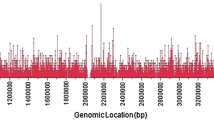Summary
While insertion sequences (IS) in Escherichia coli transpose frequently to generate spontaneous insertion mutants, such mutations are rare in Salmonella typhimurium: the only documented insertion mutation is a hisD mutation caused by the Salmonella-specific IS element IS200. To obtain more examples of IS200 insertion mutations and to seek additional types of IS elements in Salmonella, we selected and characterized 422 independent, spontaneous His− mutants and some 2100 additional mutants that are not necessarily independent. None of the mutants showed the absolute polar effect characteristic of insertion mutations or the reversion properties characteristic of insertions (low spontaneous reversion frequency and no reversion induction by chemical mutagens). A few mutants, showing a high spontaneous reversion frequency, were screened physically. No insertion mutations were found. Thus insertion mutations appear to be rare in S. typhimurium, in strong contrast to E. coli and despite the possession in Salmonella of at least one type of insertion element (IS200). These results suggest that in Salmonella transposition of the endogenous elements has been controlled. The transposition ability of the elements may have been reduced or favored target sites removed from the host genome.
Similar content being viewed by others
References
Arber W, Iida S, Jütte H, Caspers P, Meyer J, Hänni H (1979) Rearrangements of genetic material in Escherichia coli as observed on the bacteriophage P1 plasmid. Cold Spring Harbor Symp Quant Biol 43:1197–1208
Arber W, Hümbelin M, Caspers P, Reif HJ, Iida S, Meyer J (1981) Spontaneous mutations in the Escherichia coli prophage P1 and IS-mediated processes. Cold Spring Harbor Symp Quant Biol 45:38–40
Barnes WM (1979) Construction of an M13 histidine-transducing phage: a single-stranded cloning vehicle with one EcoRI site. Gene 5:127–139
Berg DE, Berg CM (1983) The prokaryotic transposable element Tn5. Biotechnology 1:417–434
Berkowitz D, Hushon JM, Withfield HR, Roth JR, Ames BN (1968) Procedures for identifying nonsense mutations. J Bacteriol 96:215–220
Bossi L, Roth JR (1980) The influence of codon context on genetic code translation. Nature 286:123–137
Casadesus J, Roth JR (1989) Transcriptional occlusion of transposon targets. Mol Gen Genet 216:204–209
Cullum J (1985) Insertion sequences. In: Scaife J, Galizzi A (eds) Genetics of bacteria. Academic Press, New York and London, p 85
Daniell E, Roberts R, Abelson J (1972) Mutations in the lactose operon caused by bacteriophage Mu. J Mol Biol 69:1–8
Davis RW, Botstein D, Roth JR (1980) Advanced bacterial genetics. Cold Spring Harbor Laboratory, Cold Spring Harbor, NY
Emr D, Silhavy T (1980) Mutations affecting localization of an E. coli outer membrane protein, the bacteriophage lambda receptor. J Mol Biol 141:63–90
Fink GR, Klopotowski T, Ames BN (1967) Histidine regulatory mutants in Salmonella typhimurium. IV. A positive selection for polar histidine-requiring mutants from histidine operator-constitutive mutants. J Mol Biol 30:81–95
Halling SM, Kleckner N (1982) An asymmetrical six-basepair target site determines Tn10 insertion specificity. Cell 28:155–163
Iida S, Meyer J, Arber W (1983) Prokaryotic IS elements. In: Shapiro JA (ed) Mobile genetic elements. Academic Press, New York and London, p 159
Johnston HM, Roth JR (1979) Histidine mutants requiring adenine: selection of mutants with reduced hisG expression in Salmonella typhimurium. Genetics 92:1–15
Johnston HM, Roth JR (1981) DNA sequence changes of mutations altering attenuator control of the histidine operon of Salmonella typhimurium. J Mol Biol 145:735–756
Jordan E, Saedler H, Starlinger P (1968) 0° and strong polar mutations in the gal operon are insertions. Mol Gen Genet 102:353–363
Kleckner N, Roth J, Botstein D (1977) Genetic engineering in vivo using translocatable drug-resistance elements: new methods in bacterial genetics. J Mol Biol 116:135–139
Kohno T, Roth JR (1974) Proflavin mutagenesis of bacteria. J Mol Biol 89:17–32
Lam S, Roth JR (1983a) IS200: a Salmonella-specific insertion sequence. Cell 34:951–960
Lam S, Roth JR (1983b) Genetic mapping of IS200 copies in Salmonella typhimurium strain LT2. Genetics 105:801–811
Lam S, Roth JR (1986) Structural and functional studies of insertion element IS200. J Mol Biol 187:157–167
Loper JC, Grabnar M, Stahl RC, Hartman Z, Hartman PE (1964) Genes and proteins involved in histidine biosynthesis in Salmonella. Brookhaven Symp Biol 17:15–50
Malamy MH (1970) Some properties of insertion mutations in the lac operon. In: Beckwith JR, Zipser D (eds) The lactose operon. Cold Spring Harbor Laboratory, Cold Spring Harbor, NY, p 359
Murray L, Hartman PE (1972) Overproduction of hisH and hisF gene products leads to inhibition of cell division in Salmonella. Can J Microbiol 18:671–681
Raibaud ORM, Braun-Breton C, Schwartz M (1979) Structure of the malB region in E. coli K-12. Mol Gen Genet 174:241–248
Roth JR (1974) Frameshift mutations. Annu Rev Genet 8:319–346
Sanderson KE, Roth JR (1983) Linkage map of Salmonella typhimurium, edition VI. Microbiol Rev 47:410–453
Schmid MB, Roth JR (1983) Internal promoters of the his operon in Salmonella typhimurium. J Bacteriol 153:1114–1119
Schmieger H (1971) A method for detection of phage mutants with altered transducing ability. Mol Gen Genet 110:378–381
Shapiro JA (1969) Mutations caused by the insertion of genetic material in the galactose operon of Escherichia coli. J Mol Biol 40:93–105
Starlinger P (1977) DNA rearrangements in prokaryotes. Annu Rev Genet 11:103–126
Vogel HJ, Bonner DM (1956) Acetylornithinase of E. coli. partial purification and some properties. J Biol Chem 218:97–106
Voll MJ (1967) Transtation and polarity in the histidine operon. III. The isolation of prototrophic polar mutations. J Mol Biol 30:109–124
Weinstock GM, Susskind MM, Botstein D (1979) Regional specificity of illegitimate recombination by the transposable element Tn1 in the genome of phage P22. Genetics 92:685–710
Whitfield HJ, Martin RG, Ames BN (1966) Classification of aminotransferase (C gene) mutants in the histidine operon. J Mol Biol 21:338–355
Author information
Authors and Affiliations
Additional information
Communicated by W. Arber
Rights and permissions
About this article
Cite this article
Casadesus, J., Roth, J.R. Absence of insertions among spontaneous mutants of Salmonella typhimurium . Mol Gen Genet 216, 210–216 (1989). https://doi.org/10.1007/BF00334358
Received:
Issue Date:
DOI: https://doi.org/10.1007/BF00334358




